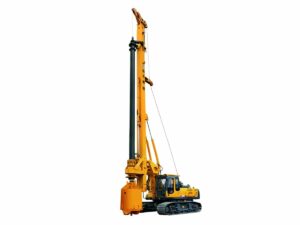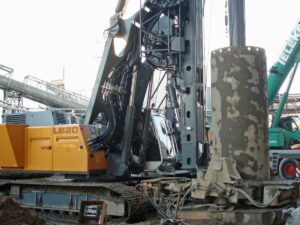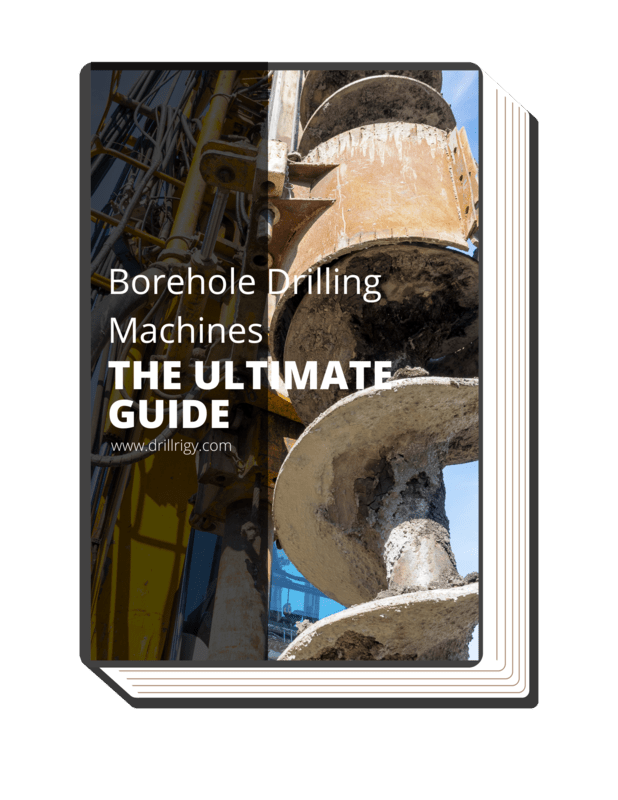2. Multifunctional Configuration and Application of Rotary Drilling Rig
Drive Configuration and Application of Steel Casing
Drive Configuration of Steel Casing
-
Adding the following modules on the basis of the main module can realize the steel casing driving method: telescopic friction (or machine lock) drill pipe;
-
Digging drilling tools (soil drilling bucket, short auger bit, etc.); connecting flower tubes, casings, and casing shoes.
Drive Application of Steel Casing
The driving device of the steel casing can play its obvious advantages in the backfill soil layer, shallow sand and pebble layer, limestone layer with many karst caves, etc. During operation, the power head transmits the torque to the steel casing and casing shoes through the drive plate, connecting disk, and connecting flower tube, so that the steel casing and casing shoes produce rotational movement, and at the same time, the pressure device of the rotary drilling rig presses down on the casing.
The casing shoe is pressurized, so that the casing is drilled into the formation by pressing down while rotating. Steel casing drilling and rotary excavation are carried out alternately, ensuring no hole collapse, no water leakage, and no waste of concrete when drilling into backfill soil layers, shallow sand and pebble layers, and limestone layers with many caves.
If the lower casing is not needed, just remove the fountain and replace it with a detachable pressure plate, which can be used for conventional drilling.
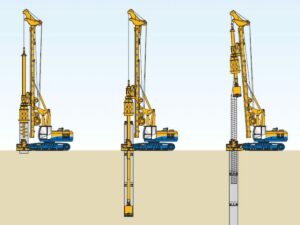
Rotary Drilling Rig Equipped With Pipe Rubbing Machine and Its Application
Function Configuration
This function adds the following modules on the basis of the main body of the drilling rig:
-
Telescopic drill pipe;
-
Rotary drilling tools (soil drilling bucket, short auger bit, etc.) or punching bucket;
-
Detachable pressure plate (connected under the power head);
-
Tube rubbing machine.
The pipe rubbing machine is connected to the installation interface on the chassis of the drilling rig, and the power is borrowed from the drilling rig. Since a hydraulic hose transition plate is installed on the oil circuit of the traveling device, the oil pipe of the traveling motor is removed when in use, and the oil pipe of the pipe rubbing machine can be connected.
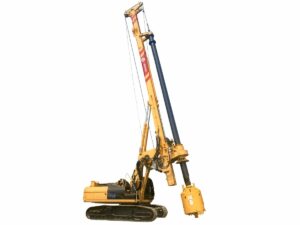
Application
The diameter and depth of the lower casing are limited due to the limitation of the torque of the power head, the pressurization force and the pull-out force of the driving configuration of the steel casing. However, the rotary drilling rig is used in conjunction with the pipe rubbing machine. Since the pipe rubbing machine can achieve greater torque, pressure and pull-out force, the diameter and depth of the lower casing are much larger, and even full casing construction can be realized.
During the construction, the pipe rubbing machine rubs into the casing and the rotary digging takes soil alternately until the designed hole depth is reached. During the hole forming process, there is no mud and no hole collapse, which is more environmentally friendly and safer. The pile holes are regular, no mud and sediment, concrete The dosage can be accurately controlled, the pouring quality is high, and the pile bearing capacity is high.
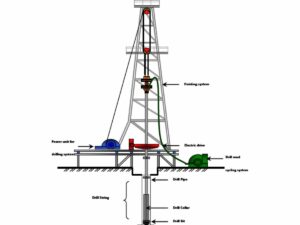
Long Spiral Configuration and Application
System Configuration
The rotary drilling rig can also be equipped with a long auger drilling tool for long helical continuous drilling into the pump pressure grouting pile (CFA) construction in the pipe. The system requires the drilling rig to add the following modules on the basis of the main module: moving pulley, mast outrigger cylinder, drill pipe guide frame, concrete delivery elbow, long auger pipe extension (optional), hollow auger with concrete pipe inside rods, long auger bits, etc.
When the system is applied, it is required to disengage the power head from the pressurizing mechanism. The power head and the drilling tool are all suspended by the main winch wire rope through the movable pulley.
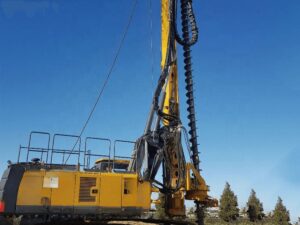
Application
The process of CFA construction method is:
-
Long auger drilling to the predetermined depth;
-
Concrete is injected to the bottom of the hole through the inner cavity of the drill pipe, and the drill pipe is lifted while pouring concrete until the concrete fills the entire pile hole;
-
Press or vibrate the reinforcement cage into the concrete.
The CFA construction method is used for drilling and soil transportation at the same time, and has high efficiency, and has different advantages when drilling small and shallow holes (<30 m).
Alternative advantages. Dry rotary drilling is used during construction, no mud circulation is required, and waste slurry pollution is avoided. It not only simplifies the drilling equipment and technology, but also is conducive to environmental protection. The construction cost is low, no vibration, no noise, no pollution, and meets relevant laws The requirements of laws and regulations are applicable to the construction of urban pile foundations with high environmental quality requirements.
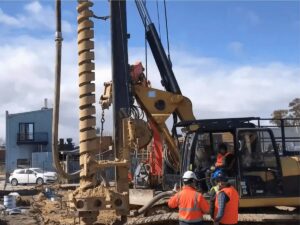
Configuration and Application of Gas Lift Reverse Circulation Drilling Into Rock
System Configuration
Adding the following configurations to the main body of the drilling rig can realize gas lift reverse circulation drilling into rock:
-
Rotating air chamber (connected under the power head);
-
Telescopic machine lock drill pipe;
-
Air pipe;
-
air compressor;
-
Reverse circulation rock drilling bucket.
The requirement of this system for the drilling rig is to design a rotating air chamber (air tap) connected under the power head as a conversion part between the rotating part and the non-rotating part of the gas pipeline. The connection interface between the air chamber and the power head is as consistent as possible with the interface of the steel casing driving device, so as to facilitate the interchange between the modules.
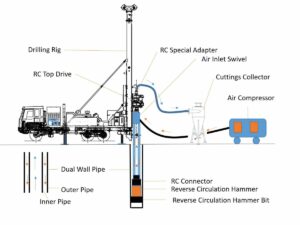
Application
The drilling system is a combination of rotary drilling rig and gas lift reverse circulation drilling technology, which can realize continuous slag discharge in one drilling cycle of the drilling bucket. The key to the realization of this drilling method is the reverse circulation rock drilling bucket. The drilling bucket is divided into upper and lower parts. The lower part is the roller cone drill, and the upper part is the slag container. The air inlet pipe and the slag discharge pipe are arranged on the wall of the cylinder.
When drilling, the broken rock chips at the bottom of the hole are carried by the compressed air into the slag container. After the slag-holding hopper is filled with slag, the drill bucket is lifted out and the slag is unloaded, and the remaining columnar core in the hole is crushed with a cross-shaped core drill bit or a short-screw-shaped rock-socketed auger bit, and then fished out with a sand bucket. In strata with well-developed joints, the core can also be taken out in one piece.
The gas-lift reverse circulation rock drilling system can still drill effectively when the uniaxial compressive strength of the rock reaches 40-200 MPa, and it is often the best solution for the last few meters of hard rock in the construction of rock-socketed piles.
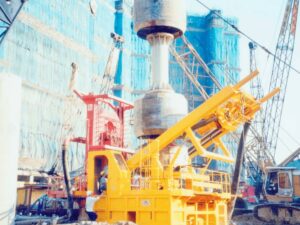
Configuration and Application of Middle Excavation Method
System Configuration and Working Principle
The drilling system requires the following configurations:
The drilling system requires another power head to be installed under the prime mover head, and the two power heads are connected as a whole through a connecting rod. When working, the upper power head drives the long helical drilling tool for clockwise drilling, and the lower power head drives the steel casing for drilling. Rotate counterclockwise to drill. The gravity of all working devices is suspended by the main hoisting steel wire rope through the movable pulley, and the working device is measured by its own weight during work.
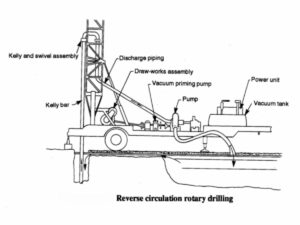
Application
The middle excavation method has obvious advantages in construction next to existing tall buildings. Due to the pressure of the original building, the pressure on the hole wall is uneven when drilling, and it is easy to collapse the hole. What is more dangerous is that it may affect the foundation of the original building. The casing of this system always follows up during drilling, which plays a role in stabilizing the foundation of the original building, and there is no mud pollution, no vibration impact, no noise, and it is a very environmentally friendly construction method.
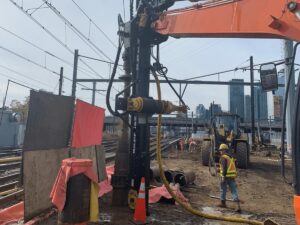
Hanging the Extrusion Expansion Disc Forming Machine or Bottom Expansion Drill Bit
Configuration
In addition to the drill body, additionally:
-
hose reel;
-
Friction telescopic drill pipe;
-
Hydraulic hose (the length depends on the hole depth);
-
Squeeze and expand the support plate forming machine or expand the bottom drill bit.
The key to realizing these two construction methods is to install a hose reel under the power head to wind the hydraulic hose, and the hydraulic hose transmits the hydraulic power to the expansion cylinder of the expansion support disc forming machine in the hole or the expansion of the bottom expansion drill bit. The oil cylinder works, and the oil circuit can be connected out from the auxiliary valve as a backup, or other oil circuits that do not work at the same time can be borrowed, such as widening the oil cylinder oil circuit.
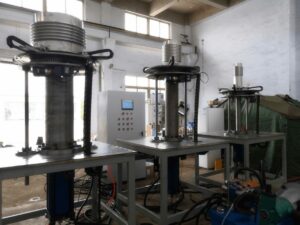
Application
The technology of extruded and expanded branch piles is a new type of pile foundation technology developed in the 1990s. Squeezed and expanded branch piles are formed by adding bearing plates or load-bearing branches to the original ordinary cast-in-place pile foundation. Due to the addition of bearing plates, the unilateral bearing capacity of extruded and expanded support-disk piles is more than twice that of ordinary cast-in-place piles. Due to the large bearing capacity of a single pile, it can be compared with ordinary cast-in-situ piles under the same load.
Shorten the pile length, reduce the pile diameter or reduce the number of piles, and even reduce the size of the cap, so it can save investment and shorten the construction period. Usually, the foundation cost can be saved by about 20%, and the construction period can be shortened by about 25%. Under the same pile diameter, the expanded bottom pile can increase the bearing capacity by 30% to 50% compared with ordinary piles.
Under the same bearing capacity, the pile diameter or the number of piles can be reduced compared with ordinary cast-in-place piles, thus saving investment and shortening the construction period. Expanded bottom piles are increasingly used in pile foundation design. In recent years, hydraulic bottom reaming drill bits have been widely used, so rotary drilling rigs should have corresponding configurations to facilitate construction.
| Method |
Configuration |
Application |
| Steel Casing Drive |
Telescopic friction drill pipe, digging drilling tools, connecting flower tubes |
Drilling into backfill soil, sand, pebble, and limestone while preventing hole collapse and water leakage. |
| Rotary Drilling Rig with Pipe Rubbing Machine |
Telescopic drill pipe, rotary drilling tools, detachable pressure plate |
Efficiently drilling larger casings with accurate concrete control and safe, environmentally friendly processes. |
| Long Spiral Configuration and Application |
Long auger drilling tool, moving pulley, concrete delivery elbow |
Continuous slag discharge in pile construction with core extraction in rock drilling, suitable for high strength formations. |
| Gas Lift Reverse Circulation Drilling into Rock |
Rotating air chamber, telescopic machine lock drill pipe |
Reverse circulation drilling for effective hard rock excavation while maintaining high environmental standards. |
| Middle Excavation Method |
Movable pulley, concrete delivery elbow, lower power head |
Stable drilling near tall buildings with casing support, ensuring minimal disturbance and eco-friendly construction. |
| Extrusion Expansion Disc Forming Machine/Bottom |
Hose reel, friction telescopic drill pipe, hydraulic hose |
Innovative extruded and expanded branch pile technology for increased bearing capacity, cost savings, and faster construction. |
3. Conclusion
The country’s increasing demands for better quality, cost control, and environmental care in pile foundation construction, coupled with diverse geological conditions, will raise the bar for pile machinery, particularly rotary drilling rigs. However, many rotary drilling rigs on the market now are one-dimensional. They can’t cater to varied geological conditions or construction methods, resulting in lower hole quality and pollution. Users also have limited choice of additional equipment, and the application area is restricted. These factors hamper the progress and profitability of rotary drilling rigs.
If the multifunctional design and application of the rotary drilling rig can be realized, the above situation will be improved. The multi-functional application of the rotary drilling rig can be realized by adopting the modular design method, and the key of the modular design lies in the design of each functional interface. The main body of the drilling rig is combined with different functional modules through functional interfaces to achieve the purpose of realizing multi-function.
Through the discussion of this article, it shows that the multi-functional design and application of rotary drilling rig is feasible. Through the multi-functional design of the rotary drilling rig, the use range of the rotary drilling rig can be greatly expanded, the purchase cost of the user’s equipment can be reduced, the quality of the hole can be improved, and the environmental protection requirements can be met.
